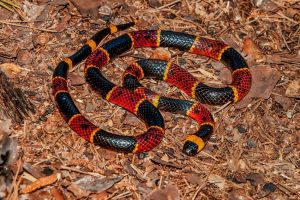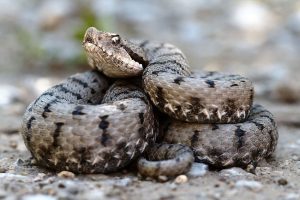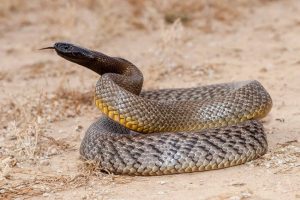The Corn Snake, with the scientific name Pantherophis guttatus, has become one of the most popular reptiles to keep as a pet. With its natural beauty and gentle temperament, the corn snake attracts not only beginners but also experienced reptile keepers. This article from Know All Animals will give you a detailed look at how to care for a corn snake, from its habitat to its diet, while also helping you understand what you need to know before deciding to own this fascinating reptile.
Scientific classification
- Kingdom: Animalia
- Phylum: Chordata
- Class: Reptilia
- Order: Squamata
- Suborder: Serpentes
- Family: Colubridae
- Genus: Pantherophis
- Species: P. guttatus
1. What is a Corn Snake?
The Corn Snake, with the scientific name Pantherophis Guttatus, is a widely distributed snake species in North America. They are extremely docile and obedient, rarely bite, and are of a very manageable size. This species is especially known for the many unique patterns on its body, which is why it is now a highly sought-after and popular pet.
They are also very beneficial to humans, as they are often found in grain stores or corn fields, where they effectively hunt mice.
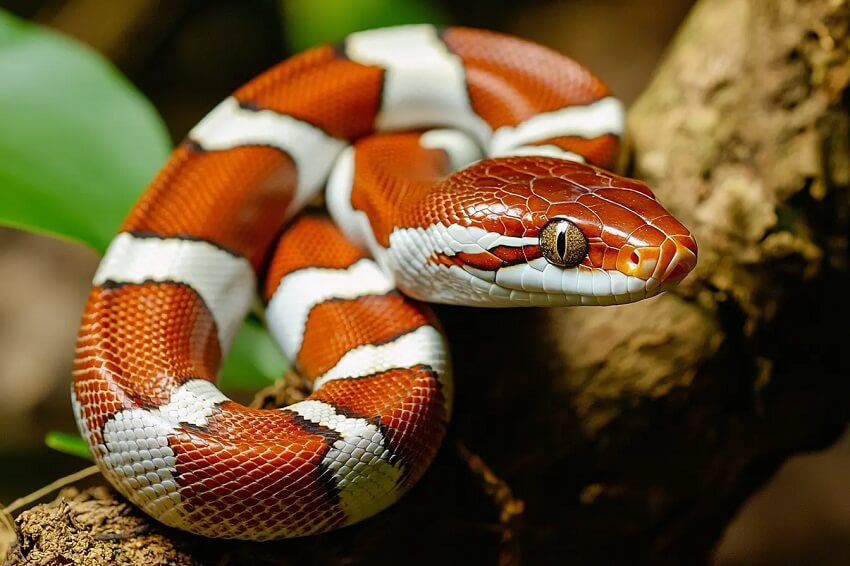
2. Origin and Habitat of the Corn Snake
Corn snakes are native to North America and were first noticed in the corn cribs of Native Americans, where the snakes would eat the mice that came to feed on the corn. This species still plays a very important role in the wild today by helping to effectively control the rodent population. They are a member of the large snake family known as Colubridae.
This snake species is medium-sized and likes to come out to forage for food around dusk and early evening. Their natural habitat ranges from fields to forests, and they can often be found slithering across southern roads just before sunset.
Although this species is common in the wild, it is also extensively bred by humans to achieve a number of incredible new color morphs and patterns. This is the main reason why this snake species is such a popular pet today.
3. Characteristics of the Corn Snake
This snake species has a very distinctive and attractive body color and pattern, which is why it is so beloved by people and chosen as a pet. Here are the key characteristics of the species.
3.1. Size
Today’s corn snakes come from many places around the world, especially North America, where they are found in large numbers. Therefore, the size of your pet corn snake when it reaches adulthood will vary depending on its specific subspecies.
Some smaller subspecies found in the southern Florida peninsula and the Florida Keys reach a size of only about 76–80 cm (30–31 inches), while those from the lower Mid-Atlantic states can grow to between 1.5–1.8 m (5–6 feet). Compared to pythons, this species has a modest girth and weight, only weighing about 2 kg (4.4 lbs).
3.2. Colors
One reason why the corn snake is such a popular pet is the wide variety of its colors and appearance. Breeders are constantly creating new color variations and morphs. That being said, not all corn snakes have striking patterns and colors.
Many larger, wild species exhibit a “self-soiling” effect, where their colors are clouded by a pigment called melanin. A snake’s appearance is made up of two components: its pattern and its color.
Their patterns and colors can vary and are inherited through genetics. Currently, there are quite a few main patterns and shapes that can be found. Specifically:
Patterns
Here are some of the most popular and distinct patterns of this snake species:
Striped or Motley Pattern: These patterns appear when the snake’s dorsal blotches lengthen and sometimes merge. It’s like looking at a terraced field that turns into a perfectly even, solid stripe.
Band Pattern: The band pattern is relatively new and is still being researched and bred. The goal is to have scales with clearly defined crossbands that run from the belly plates all the way up the snake’s back.
Zigzag Pattern: This pattern first appeared in the 1980s in Florida. The patterns are a zigzag shape, as if their regular square or rectangular blocks are still connected but have been vertically separated and spread out, like a zipper.
Plain and Unpatterned: They can also have a plain belly, which is a belly without the checkerboard pattern that most other snake species have. The unpatterned morph is also relatively new. Some breeders believe that unpatterned body sections are the result of extreme striping effects. One interesting unpatterned corn snake is the Granit Morph.
Corn Snake Color Morphs
Today, due to the popularity of keeping snakes as pets, owners love snakes with strange, mutated colors. Because of this, many snakes with color mutations have been born. Specifically:
Albino: This means “no black pigment” and is also referred to as albinism. This trait has been bred to create beautiful cream-colored and multicolored snakes, or can create a completely white or “candy cane” color.
Anerythrism: Snakes with this mutation lack red and yellow pigments and are primarily black and white, gray, or reddish-brown in tone. Sometimes there are traces of yellow on their throat or chin, but they are usually caused by natural pigments in their food.
Hypomelanism: Unlike the albino mutation, this condition is when a snake has a reduced amount of skin pigment. The distribution of black pigment is lessened, which can cause black skin areas to turn a chocolate brown or disappear entirely. Basically, this is a mutation that reduces the black pigment to make the snake’s base color brighter. This can create colors like lava, sunset, or a red and white snake.
Caramel: The caramel color mutation is marked by an increase in yellow pigment and a complete lack of red and orange, resulting in a cream or caramel-colored snake.
Lavender: This species has a very striking lavender color, with purplish-gray patterns on a lighter gray or white background. Some lavender snakes have strange glowing red eyes, like those of a ghost snake.
3.3. Lifespan of a Corn Snake
Corn snakes that are kept as pets, and are not in a breeding program, tend to live longer and happier lives than those used for breeding. The record for the longest-lived captive corn snake is 32 years and 3 months, and snakes kept in zoos often live past the 20-year mark.
If you are considering getting a snake as a pet, just know that you are committing to a very long-term relationship.
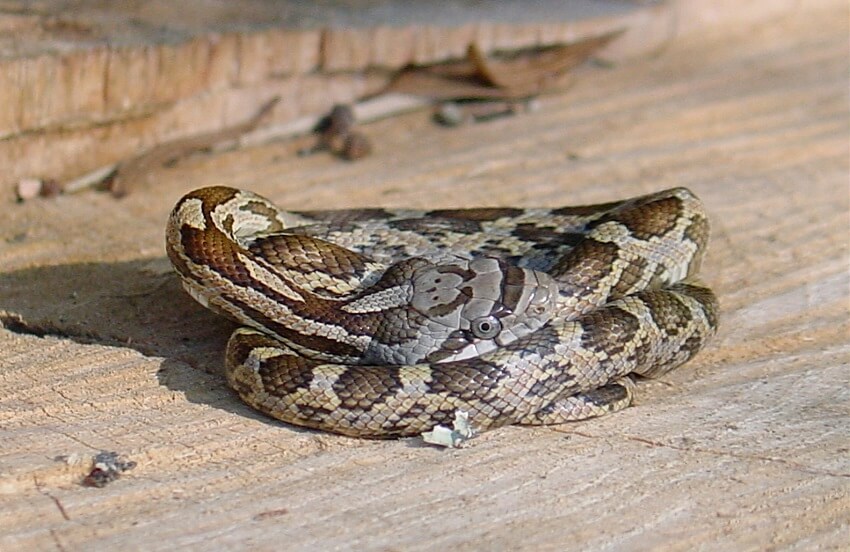
4. Is the Corn Snake Venomous?
This species is a non-venomous snake and is completely harmless to humans. In fact, they are beneficial to people because they help to hunt and drive away mice that eat corn. For this reason, the corn snake has become a very popular pet.
5. What Are the Different Types of Corn Snakes?
There are many types of corn snakes around the world. Below are some of the most popular species that you can check out:
5.1. Mexican Corn Snake
This species is found in Mexico, adjacent to western and southern Texas. They have a distinct silver and green head, which fades over time to a brown color.
5.2. Keys Corn Snake
Also known as Rosy Ratsnakes, this species is found in some parts of Florida. They are marked by a reduction in black pigment, a broken belly pattern, and a paler overall appearance. This snake can come in many colors, from silver to orange.
5.3. Slowinski’s Corn Snake
Slowinski’s Corn Snake comes from western Louisiana and the pine forests of eastern Texas. This species has many different colors, but most are not as striking as the average corn snake.
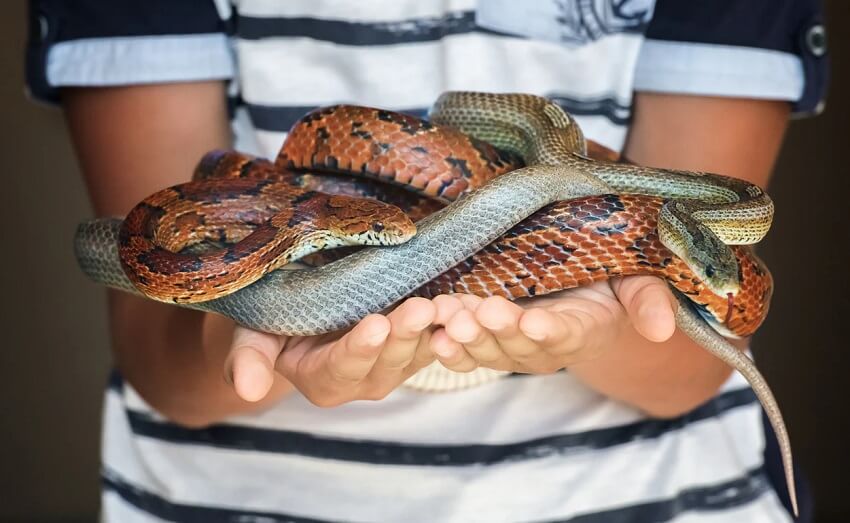
6. The Best Way to Care for a Corn Snake
If you are looking to get a snake as a pet, here are some basic tips for effectively caring for this reptile.
6.1. The Cage
When raising this snake species, you can use a plastic container or a styrofoam box as a cage. When you’re raising them, you should only keep one snake per cage to ensure safety and stable development. In addition, corn snakes are very good climbers, so you need to make sure the cage has no openings for them to escape.
You should add some climbing branches or rocks to the cage for the snake to climb on and bask in the sun. In addition, the cage should have a water dish and a hideout for the snake to take shelter. You should also line the floor of the cage with a layer of wood shavings to make it as comfortable as possible for them.
6.2. Living Environment
Another essential feature for a good snake cage is a hideout. If a snake is exposed to humans or the environment 24/7 and can’t find any privacy, it will become stressed and sick. You can make your own hideout from a shoebox or plastic dish, or you can buy a fancy one from a reptile store.
Snakes prefer to burrow rather than climb, but you can place branches and plants in your pet’s cage if you like the look. Keep in mind that, like everything else in a snake’s cage, you will need to clean them periodically. It’s up to you whether you use real or fake plants, just make sure they are safe for the snake.
6.3. Temperature and Lighting for the Cage
Corn snakes don’t require lighting, but some colorful species look better in daylight, so you might want to use a fluorescent bulb to enhance your pet’s appearance. Whatever you decide, never place a light bulb inside your snake’s cage, as snakes have a tendency to coil around the light and will burn their skin.
A happy, healthy corn snake enjoys a range of temperatures in its cage. This gives them the ability to thermoregulate, which helps with digestion and can help keep their immune system strong.
They thrive in a temperature range similar to humans, from 21–26°C (70–80°F). You should try to set up a “hot spot” for the snake to warm up on and keep a thermometer there to ensure the snake is always within a stable temperature range.
6.4. Humidity
Last, but not least, is their water/bath bowl. Because this species is native to the humid southeastern United States, they prefer a humidity level of 40–60% or higher.
Most homes have a relatively lower humidity level than the outdoors, which can cause dehydration and incomplete shedding. To avoid these and other health problems, invest in a proper hygrometer to monitor the humidity level of your snake’s enclosure and provide a more humid environment if needed.
You can cover some of the cage’s main ventilation areas to prevent moisture from escaping. Try placing a piece of newspaper or aluminum foil over half of the enclosure’s screen top or adding a second, larger water dish inside the box.
They enjoy soaking in water, but if they are too hot or too dry, they will soak for long periods of time. Keep an eye on the time your snake spends soaking. Long soaks can be a sign of illness, improper cage temperature, or a mite infestation.
6.5. What Do Corn Snakes Eat?
Feeding your pet corn snake is relatively easy. They are strict carnivores, eating almost exclusively warm-blooded prey like rodents and birds in the wild.
A good rule of thumb for determining the correct food size for your snake is to try to choose a food item that is no more than 1.5 times the snake’s girth at its midsection.
This species enjoys mice and small rats, usually one or two a week. They love to hunt and forage, so it’s best to use live or pre-killed and thawed prey.
Young snakes can begin eating after their first shed after birth. For a young snake with a length of 25–30 cm (10–12 inches), a pinky mouse (a hairless newborn mouse) is the perfect first meal.
Adult snakes with a length of 91–122 cm (3–4 feet) do well with one to two appropriately sized prey items every one to two weeks.
For snakes with a length of 137–152 cm (4.5–5 feet), a single meal can consist of one adult rat, two pinky rats, or one weaned rat.
Some tips for feeding your corn snake: Always feed them one at a time, and allow your snake to finish digesting its meal for 24 hours before trying to handle it, otherwise, you run the risk of it regurgitating its meal. Never leave a live prey animal in your snake’s cage for an extended period. Leaving a live prey animal in your snake’s cage can result in the snake being bitten.
7. Caring for a Corn Snake During Shedding
7.1. Causes of Difficult Sheds
Unlike other animals, a reptile’s skin doesn’t grow with its body. They are forced to shed their old skin for a new one. Shedding is the process where the old skin peels off and is replaced with new, more elastic skin. In general, shedding is a sign of a snake’s growth. However, if the snake’s skin is worn down during daily activities, they may shed more frequently.
Symptoms of a difficult shed are when the old skin cannot come off or peels off in pieces. The main cause of this is low humidity in the cage. This is especially true in the winter in northern Vietnam, where people use heaters that make the air very dry.
If old skin remains on the body, the corn snake will be harmed. The retained skin will pull moisture from the snake’s body, which not only affects their appearance but can also cause them to become dehydrated. Not to mention, this skin can harbor bacteria, leading to fungal infections.
For this retained skin, you can use a gentle adhesive tape. Stick it to the dead skin on the snake to remove it. You should note that during the first week of the shedding process, you should not try to “help” them. The old skin being removed too early will cause severe swelling of the new skin underneath.
7.2. Helping a Corn Snake Shed Safely
Everyone knows that snakes shed, which is a challenge that snakes face many times after they mature. A corn snake may shed once every few months. Before a snake sheds, owners will notice that its beautiful colors will gradually fade, and its eyes will turn a gray or blue color.
3 or 4 days before shedding, their eyes will return to normal. You will also observe them frequently rubbing their bodies against objects, which is a sign that they are beginning to shed. Owners can also place a damp towel or damp moss inside the hideout to help soften the skin. After the snake has shed, the owner should check to make sure the new skin is clean to prevent problems.
Corn snakes are not very expensive, so any pet owner who is interested can try keeping one. After bringing them home, you must give them time to adjust before giving them their first meal.
After feeding them for 2 days, you can handle them and play with them. You should remember to feed them to understand them better, protect them, and appreciate their unique liveliness and charm. Just like any other living creature, respect them and live in peace.
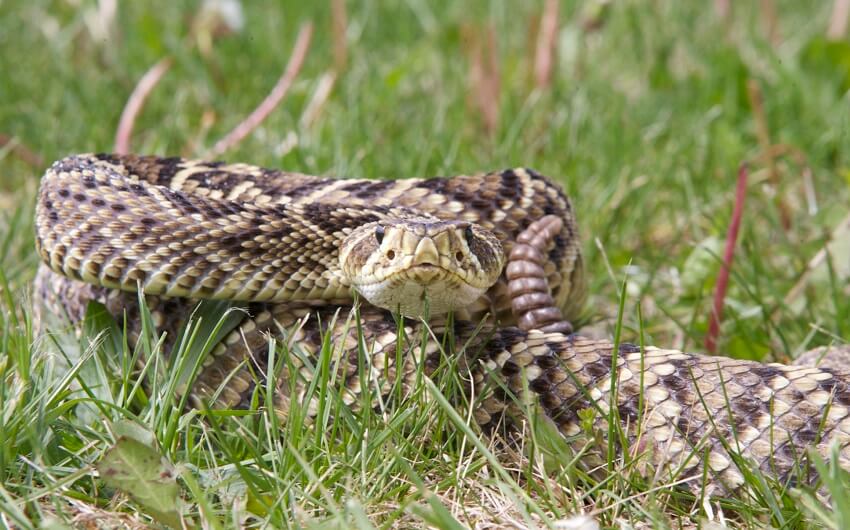
8. How Much Does a Corn Snake Cost?
Currently, the market price for this snake species ranges from $25 to $35 per snake, depending on its size, color, and patterns. Snakes with a larger size, striking colors, and unique patterns are usually more expensive and quite rare.
If you are looking to buy a snake, you should look for pet stores or reptile breeding facilities. These places often have a large number of snakes, so you can easily choose one that is right for you. In addition, you can also find many unique pets, including snakes, on reptile or pet forums and groups on Facebook. However, when buying online, you need to be more careful to avoid being scammed.
9. FAQs
1. Are corn snakes good pets for beginners?
Yes, corn snakes are one of the best reptile pets for beginners. They are calm, non-venomous, easy to handle, and don’t require overly complex care.
2. What do corn snakes eat?
Corn snakes primarily eat frozen-thawed mice. Juveniles eat smaller prey, while adults typically eat once every 7–10 days depending on size and age.
3. How big do corn snakes get?
Adult corn snakes usually grow to about 5–7 feet (1.5-1.8 meters) long. They are slender and not too bulky, making them manageable even for small enclosures.
This article contains all the information on the unique snake species that Know All Animals has shared with you. We hope it has helped you understand and answer your questions about what a Corn Snake is, if it’s venomous, how to care for it, and how much it costs, in a detailed and accurate way. If you still have questions or have suggestions for the article, please leave a comment, and we will respond as soon as possible. Thank you for reading our article.
References: Corn snake – Wikipedia

